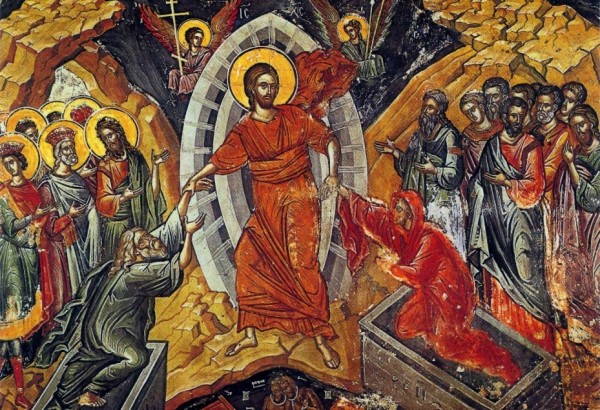The Five-Fold Argument for the Resurrection
by Joe Heschmeyer
Filed under The Resurrection
The New Testament consists of first-century, seemingly first-hand accounts of the life, death, and resurrection of Jesus Christ. It also claims to be an eyewitness account and makes some mighty bold claims about what the authors saw and heard. Yet a first-century audience (that is, an audience which would have been able to call "shenanigans" if the authors were just making things up) believed these accounts, copied them, and spread them both textually and orally throughout the entire Roman Empire and to faraway places like India.
That's a pretty good indication of credibility there. This doesn't, by the way, rely on you assuming a priori that the Bible is Scripture and therefore inspired; just that you approach it as you would any other historical text, since it's clearly arguing for what were then recent historical events, not telling some long-ago legend.
On this Good Friday, the day Christians traditionally commemorate the death of Jesus on the cross, let's examine the evidence surrounding his death and resurrection. I'd like to look at five specific examples.
1. The Sweat Turning to Blood
In the Agony in the Garden, Luke mentions (Luke 22:44) that Jesus' sweat fell "like drops of blood." That's a medical condition called hematohidrosis, which the Indian Journal on Dermatology described as "very rare." It occurs under extreme stress in a handful of people. Now, St. Luke was a doctor (as St. Paul mentions in Colossians 4:14), which is probably why he's the only Gospel writer to draw attention to this fact: this is unlike what a first-century doctor would have seen in his day-to-day practice (and, as I mentioned, it's still very rare).
So it's significant that this first-century source is describing a medical condition that was largely unknown, but which we now know to be stress-related. That is, the source is describing information that he would have been unlikely to make up, because even if Luke were somehow aware of hematohidrosis, why would he include that detail? To try and convince other first-century dermatologists? It's a detail which seems supernatural and incredible, not a detail which seems natural and credible... yet we now know it corresponds to modern medicine. This suggests that Luke's testimony is accurate: that there was a real Jesus of Nazareth, who really did sweat blood in anticipation of His Crucifixion.
2. Blood and Water Flowing from the Side of Christ
John 19 contains another gory detail in its gruesome account of the aftermath of Jesus' death (John 19:31-37):
"Now it was the day of Preparation, and the next day was to be a special Sabbath. Because the Jews did not want the bodies left on the crosses during the Sabbath, they asked Pilate to have the legs broken and the bodies taken down. The soldiers therefore came and broke the legs of the first man who had been crucified with Jesus, and then those of the other.
But when they came to Jesus and found that he was already dead, they did not break his legs. Instead, one of the soldiers pierced Jesus' side with a spear, bringing a sudden flow of blood and water. The man who saw it has given testimony, and his testimony is true. He knows that he tells the truth, and he testifies so that you also may believe. These things happened so that the scripture would be fulfilled: 'Not one of his bones will be broken,' and, as another scripture says, 'They will look on the one they have pierced.'"
This is packed with evidence. First, the author is familiar with Jewish religious practices. He says in verse 31, "Now it was the day of Preparation, and the next day was to be a special Sabbath." That's a Passover reference, obviously, and it explains why Jesus' followers celebrated Passover a day before the Pharisees (they were of a Jewish school which always observed Passover a day early when it fell on the Sabbath).
Second, the author is aware that the bodies must be taken down (for reasons of ritual purity under the Levitical code.)
Third, the author is all too familiar with crucifixion. He's aware, for example, that the Romans broke the legs of their victims on the cross—the reason being that without the support of your legs, you can't pull your body up to breathe, and you slowly die of asphyxiation. Though it sounds counter-intuitive, lack of oxygen is what frequently killed the victims of crucifixion, not having nails driven through their wrists.
Fourth, the author hints at several lines of Biblical fulfillment. The Passover Lamb's bones weren't broken (Exodus 12:46; Num. 9:12) nor were the bones of the Messiah to be broken (Psalm 34:20). And there is a strangely God-like prophecy in Zech. 12:10, that the Chosen One will "pour out on the house of David and the inhabitants of Jerusalem the Spirit of grace and supplication," while they "will look on me, the one they have pierced, and they will mourn for him as one mourns for an only child, and grieve bitterly for him as one grieves for a firstborn son."
Given that the Christians believe that Christ is the only-begotten of the Father (John 3:16), this detail manages to fulfill all sorts of really intricate prophesies. If you think that this is easy, try it sometime: try and write a short fictional account of someone (anyone) living in the present who fulfills the Biblical prophesies, and make it believable.
Finally, and this one blew my mind, the blood and water comport with medical evidence. After Jesus died, his body stopped metabolizing the water, so an upward piercing from a spear could have easily torn the lining of the stomach, causing the blood and water to pour out. John explicitly mentions this detail, but it's not one a fictional writer is likely to have thought of (unless he'd cut open dead bodies, which Jews were forbidden to do).
So far, then, we have reliable evidence that there was a Jesus who knew (and seemingly dreaded) going to the cross, but went anyways, and was killed. Both Luke and John mention pretty specific medical details unlikely to be concocted. All of this suggests that Jesus really lived and really died on the cross. There are dozens more verses that support this point, besides the ones above, as well as extra-Biblical sources acknowledging that there was a Jesus who died on the cross.
3. The Tomb Was Guarded
Matthew 27:62-66 notes an important detail:
"The next day, the one after Preparation Day, the chief priests and the Pharisees went to Pilate. 'Sir,' they said, 'we remember that while he was still alive that deceiver said, 'After three days I will rise again.' So give the order for the tomb to be made secure until the third day. Otherwise, his disciples may come and steal the body and tell the people that he has been raised from the dead. This last deception will be worse than the first.'
'Take a guard,' Pilate answered. 'Go, make the tomb as secure as you know how.' So they went and made the tomb secure by putting a seal on the stone and posting the guard."
This account is giving specific names and dates: Pilate, the chief priests (who were identifiable at the time), and the Pharisees; and the day is the one after Preparation Day (that is, Passover). So Matthew is publicly accusing both the religious and political authorities of having posted a guard outside of the tomb of Jesus. Are we to believe that he was lying, slandering them while they're still alive? But we know from another detail that there's not even a controversy about whether the tomb was guarded or not...just how the guards managed to screw up so badly. Matthew 28:11-15 has the other half of the story:
"While the women were on their way, some of the guards went into the city and reported to the chief priests everything that had happened. When the chief priests had met with the elders and devised a plan, they gave the soldiers a large sum of money, telling them, 'You are to say, 'His disciples came during the night and stole him away while we were asleep.' If this report gets to the governor, we will satisfy him and keep you out of trouble.'
So the soldiers took the money and did as they were instructed. And this story has been widely circulated among the Jews to this very day."
Again, remember when Matthew is writing: he even gives a nod to it, when he talks about how rumors are still circulating "to this very day" about the guards. So we know the Tomb was guarded beyond any serious question.
4. Jesus Appears in the Flesh and Eats in Their Presence
In Luke 24:36-43, we see one of the Resurrection appearances of Jesus:
"While they were still talking about this, Jesus himself stood among them and said to them, 'Peace be with you.'
They were startled and frightened, thinking they saw a ghost. He said to them, 'Why are you troubled, and why do doubts rise in your minds? Look at my hands and my feet. It is I myself! Touch me and see; a ghost does not have flesh and bones, as you see I have.'
When he had said this, he showed them his hands and feet. And while they still did not believe it because of joy and amazement, he asked them, 'Do you have anything here to eat?' They gave him a piece of broiled fish, and he took it and ate it in their presence."
This is one of the most important post-Resurrection appearances, from a logical standpoint. Jesus' twelve disciples are assembled, they see someone simply appear in their midst, and they're not sure if it's the risen Christ, or a ghost. So they put him to the test. Or, more precisely, he offers his hands and feet, and lets them touch him. Then, he takes a piece of their fish and eats it.
To them, he was disproving that he was a ghost. To us, it also disproves the hallucination hypothesis. Hallucinations tend to be either auditory, visual, or tactile. That is, typically, a person hallucinating either sees or hears or feels something which isn't there. There are cases of hallucinations involving more than one, although I've never heard of any cases where one was all three. Certainly, there's no such thing, medically speaking, of twelve people simultaneously having a mass hallucination involving them all collectively seeing, hearing, and touching something which wasn't there.
So the hallucination hypothesis is out. But just to put another nail in its coffin, Jesus eats a fish. So even if, contrary to everything we know about the relevant medicine, twelve people coincidentally had the same extremely rare form of hallucination, it would still not explain where the piece of fish went. They had a piece of fish, they watched him eat it, and there no longer was a piece of fish. And remember, they had the fish with them, so it wasn't like they hallucinated the fish, too.
So the twelve disciples are either lying or actually saw the risen Christ. They're not just telling a pious legend nor are they confused about what they saw. There's just no way that they mistook something else for seeing, hearing, and feeling the risen Christ and watching him eat.
And finally:
5. The Tomb is Empty
In Acts 2, Peter gets up in Jerusalem during a religious feast, and loudly proclaims that Jesus Christ is risen, and that his tomb is empty. It's too early in history for Luke to be making the story of Peter's speech up, and it's way too early for Peter to be lying about the location of Jesus' body. After all, his tomb wasn't far away, and the men who put him there were almost certainly within in the city. Plus, as we've now established, there were guards present at the tomb, who could have also lead the curious to go see it.
Conclusion
In sum, we know that (1) there was [or is] really a Jesus Christ who was crucified; (2) he really died on the cross; (3) there were rumors of a resurrection, and so guards were posted outside his tomb; (4) his disciples claim to have seen, spoke with, and touched him in risen form shortly after his death, and watched him eat; and (5) his tomb was empty.
All of this points heavily to the fact of Jesus' resurrection. Certainly, it's the answer that the disciples swear up and down is true. And they're willing to go to their deaths for it, which suggests they at least think it's true. That is, they're not lying. (Note: Being willing to die for a claim doesn't ensure the claim is true, but it does strongly suggest one thinks it's true.) None of the disciples recant after Jesus' death, even though all but John are martyred for it. And remember: these men were one and all pious Jews, claiming that Jesus Christ is the One True God. If he's not, and they know he's not, they're about to be ripped apart by animals and go straight to Hell.
Beyond this, none of the other explanations for this evidence even come close to making sense, particularly taking the full scope of evidence. That is, even if the Twelve hallucinated Jesus in (4), how would that result in an empty tomb (5)? And the famous "swoon" theory, that Jesus didn't really die, explains (5), but doesn't come close to make sense of (3) or (4) since, remember, Jesus appeared without walking in through the door, and it runs directly foul of (2) as well as common sense.
Taken as a whole, all the evidence suggests that roughly two-thousands years ago, Jesus of Nazareth was crucified, died, and rose again on the third day, just as the Catholic Church has taught since then.
Related Posts
Note: Our goal is to cultivate serious and respectful dialogue. While it's OK to disagree—even encouraged!—any snarky, offensive, or off-topic comments will be deleted. Before commenting please read the Commenting Rules and Tips. If you're having trouble commenting, read the Commenting Instructions.













